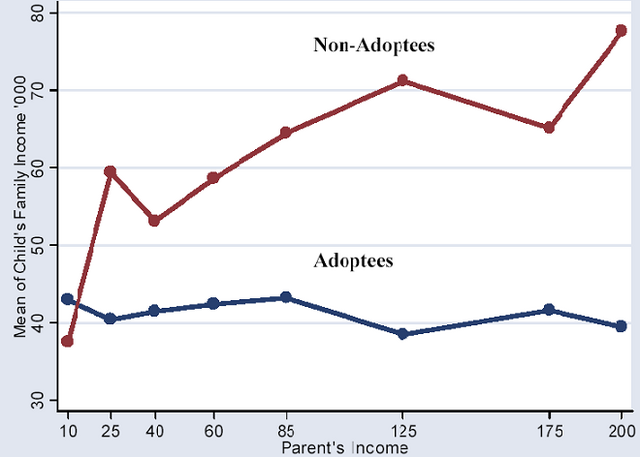The Economix graph shows SAT scores versus parent’s income. Manikew goes off about omitted variable bias and claims the relationship is because smart people make more money and pass on their smart, money-making genes.
Marginal Revolution presents evidence from a grand experiment that seems to back this up. Turns out, Holt International randomly assigned children up for adoption to parents in the 70s and 80s. This means that we wouldn’t expect any difference between the innate intelligence of children assigned to rich folks versus poor folks so any difference in outcomes between children adopted by rich families versus poor families is due purely to nurture.

Wow! This graph seems to show a huge, huge role for nature and a very limited role for nurture. This rocked my world a little bit. I’m a firm believer in the power of early childhood education, etc, but this graph seems to show that even if you do the most extreme intervention imaginable – literally scoop up infants from poor families and drop them in rich families – they wouldn’t have the genes to keep up with the rich families’ biological children.
Sounds too crazy to be true, doesn’t it? Well, don’t worry, it probably isn’t true – the graph doesn’t control for age, sex or education. The adopted children are 30% male and have a mean age of 27.8, compared to the biological children who are 61% male and have a mean age of 34. There’s that pesky omitted variable bias again. Without controlling for these things, the average difference in biological versus adopted children’s income is $19,000, but this shrinks to just $1,600 when the controls are added.
The paper the graph is lifted from is interesting raises a more interesting question: why are biological children are getting more education? (Which they do appear to be) Hard to say – nature is certainly part of the answer, as is mother’s nutrition. Family size is also much more important in predicting adopted children’s education than biological children’s, suggesting that, as much as we’d like to think otherwise, there may be some preference for biological children in adoptive families.



No comments:
Post a Comment